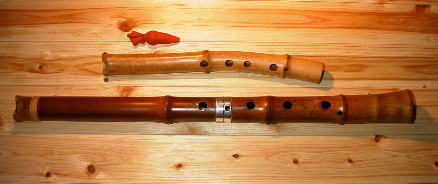 |
The shakuhachi in the photo above is one shaku and a few millimeters in length with the lowest note at B. It plays an octave higher than a 2.1, and is 86mm in circumference. Even though it is a pon-nuki (or ji-nashi, made without plastering the bore with ji) the balance is very good and the instrument plays well all the way up to ura-hi (hi with the thumb-hole open). The utaguchi (mouthpiece) insert is in Kinya-style, based on a style predating both Kinko and Tozan styles, combining design and function in a way that protects and enhances the beauty of bamboo. I was so happy with this 1.2 that I had to use ivory for the utaguchi insert. See the photo below. The original bamboo stalk was dead at the top when I found it in a grove somewhere on the Kanto plane, (No, I'm not about to say where.) The shape was really interesting, but the diameter was so small I didn't know what I could use the bamboo for. So instead of digging the root out of the ground, I used a saw to cut the bamboo as close to the root as possible. |
 |
Quite a curve. Obiviously I did not straighten the bamboo. |
 |
Juxtaposed with a 1.8. It's barely wider than a broom handle. The red object is an antique-style utaguchi cap, called a "pepper" because of the resemblance. A rather stylish name, don't you think? |
 |
This is the Kinya-style utaguchi insert. I rarely use ivory, but it is renowned for its strength and resilience. |
 |
The node for a branch, still intact. Shakuhachi makers usually discard this kind of bamboo. |
 |
I etch the signature with a hot electric
pen. This is tense work, as you have to get it right the first time. Because they are hand-done, each signature is slightly different. |
 |
A branch node here, too. The bore has a light wash of lacquer. |